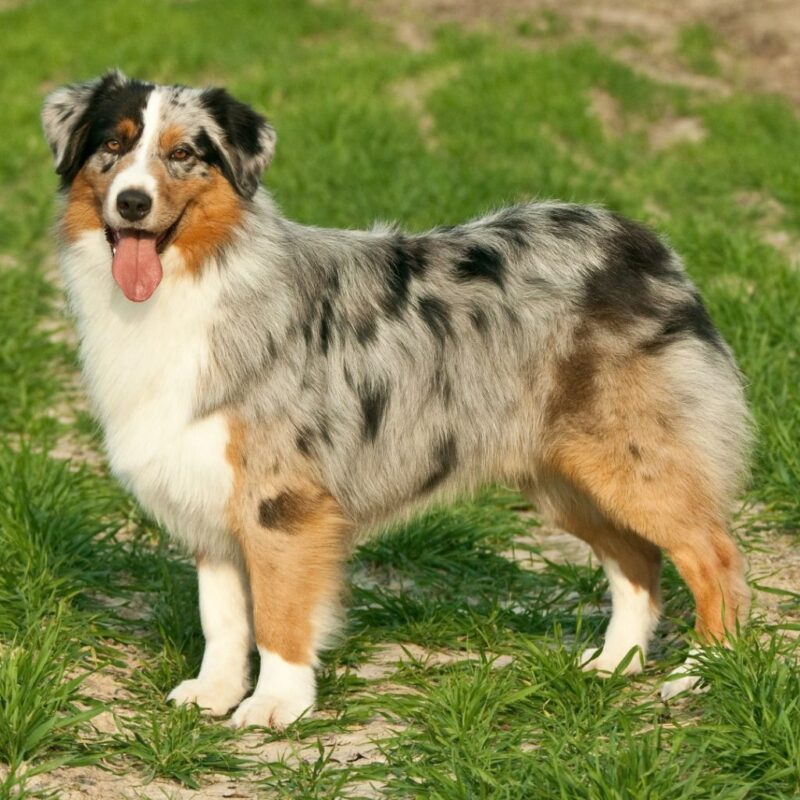Australian Shepherd – The Energetic and Intelligent Herding Dog
The Australian Shepherd, or “Aussie”, is a highly energetic, intelligent, and affectionate breed known for its herding abilities, agility, and strong work ethic. Despite its name, the breed was actually developed in the United States, where it became a favorite among ranchers and farmers.
In this article, we’ll explore the history, physical traits, temperament, care requirements, and health considerations of the Australian Shepherd.

1. History and Origins
The Australian Shepherd was developed in the United States in the 19th century, despite its misleading name.
- The breed originated from sheepdogs brought to America by Basque shepherds who had traveled through Australia before arriving in the U.S.
- American ranchers refined the breed, selecting dogs with intelligence, agility, and strong herding instincts.
- Over time, the Aussie became a staple on farms and ranches, excelling at herding livestock and even working in rodeo performances.
Today, Australian Shepherds are beloved companions, working dogs, and competitive athletes in dog sports like agility, obedience, and herding trials.
2. Physical Characteristics, Size, and Lifespan
Australian Shepherds are medium-sized, well-balanced dogs with a muscular and agile build.
Key Physical Features:
- Coat Type: Medium-length, double coat that is weather-resistant.
- Common Colors: Blue merle, red merle, black, and red, often with white markings or tan points.
- Eyes: Can be brown, blue, amber, or a mix of colors (heterochromia).
- Ears: Medium-sized and triangular, set high on the head.
- Tail: Can be naturally bobbed or long (docked in some countries).
Detailed Measurements:
- Height:
- Males: 20 to 23 inches (51 to 58 cm)
- Females: 18 to 21 inches (46 to 53 cm)
- Weight:
- Males: 50 to 65 pounds (23 to 29 kg)
- Females: 40 to 55 pounds (18 to 25 kg)
- Life Expectancy: 12 to 15 years
3. Personality and Temperament
Australian Shepherds are known for their intelligence, energy, and loyalty.
Temperament Traits:
- Highly Intelligent: Can quickly learn commands and problem-solving tasks.
- Energetic and Playful: Needs plenty of exercise and mental stimulation.
- Hardworking and Loyal: Bonds closely with their owner and thrives when given a job.
- Protective but Not Aggressive: Naturally cautious with strangers but not aggressive.
- Social and Friendly: Loves spending time with family and other pets.
This breed needs an active household to stay happy and well-behaved. Without enough activity, they may become bored and destructive.
4. Care and Training
4.1. Nutrition and Feeding
Australian Shepherds require a high-energy diet to support their active lifestyle.
- High-quality dog food: Choose formulas with lean protein and healthy fats.
- Portion control: Avoid overfeeding to prevent obesity.
- Multiple meals: Feed twice daily instead of one large meal.
4.2. Exercise and Physical Activity
Australian Shepherds have extremely high exercise needs.
- Daily Exercise: At least 1.5 to 2 hours of intense activity.
- Mental Stimulation: Interactive toys, agility training, and herding activities.
- Dog Sports: They excel in agility, flyball, frisbee, and obedience trials.
Without enough exercise, they may develop bad habits like excessive barking and chewing.
4.3. Training and Socialization
Early training is crucial for good behavior and obedience.
- Obedience Training: Teach commands like sit, stay, and recall from a young age.
- Leash Training: Prevent excessive pulling due to their high energy.
- Socialization: Expose them to different people, places, and experiences.
Aussies love to learn and respond well to positive reinforcement training.
5. Health Considerations
Australian Shepherds are generally healthy, but they are prone to certain hereditary conditions.
Common Health Problems:
- Hip Dysplasia: Affects mobility and can lead to arthritis.
- Collie Eye Anomaly (CEA): A genetic condition affecting vision.
- Epilepsy: Some Aussies are prone to seizures.
- Deafness: More common in merle-colored Australian Shepherds.
- Multidrug Sensitivity (MDR1): A genetic mutation that affects drug metabolism.
Preventive Care:
- Regular Vet Check-ups: Early detection of health problems.
- Genetic Testing: Helps breeders reduce hereditary issues.
- Joint Supplements: Omega-3 and glucosamine support joint health.
6. Grooming Needs
Australian Shepherds are moderate shedders and require regular grooming.
Grooming Tips:
- Brushing: 2–3 times per week (daily during shedding seasons).
- Bathing: Every 6–8 weeks or as needed.
- Ear Cleaning: Check weekly to prevent infections.
- Nail Trimming: Every 2–3 weeks to prevent overgrowth.
Their double coat helps regulate body temperature, so shaving is not recommended.
7. The Australian Shepherd as a Companion
Australian Shepherds are ideal pets for active individuals or families who can provide daily exercise and mental stimulation. They are best suited for:
- Farmers and ranchers – Excellent herding dogs.
- Active families – Great for outdoor activities like hiking and running.
- Dog sports competitors – They excel in agility and obedience trials.
They may not be suitable for sedentary owners or apartment living unless given enough exercise.
8. Conclusion
The Australian Shepherd is a high-energy, intelligent, and loyal breed that thrives in active households. With the right training, exercise, and mental stimulation, they make fantastic companions and working dogs.
If you’re looking for a smart, playful, and hardworking dog, the Australian Shepherd might be the perfect fit for you!


